Sanny reckons he has got the measure of Surly’s biggest ever fat bike. Is it the best fat bike ever? Or does size not really matter?
- Brand: Surly
- Product: Moonlander 2.0
- Price: £4,699.99
- From: Ison Distribution
- Tested by: David ‘Sanny’ Gould for 6 months
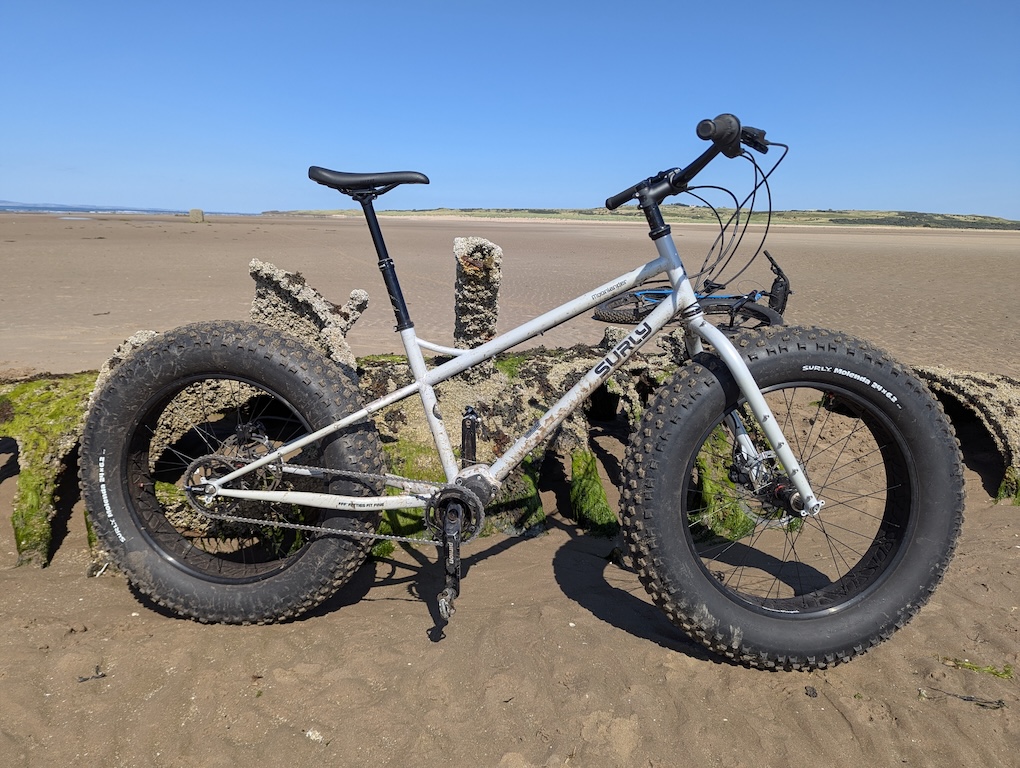
Pros
- Outstanding levels of grip on even the techiest of terrain
- Despite the outlandish looks, it still rides like a bike
- The smiles on people’s faces when they see one in the flesh
Cons
- Reduce the size of the front chainring to make it even more of a slow speed traction beast
- Fit a dropper post that is long enough for the taller rider
- Replace the saddle with something more comfortable
Our rating
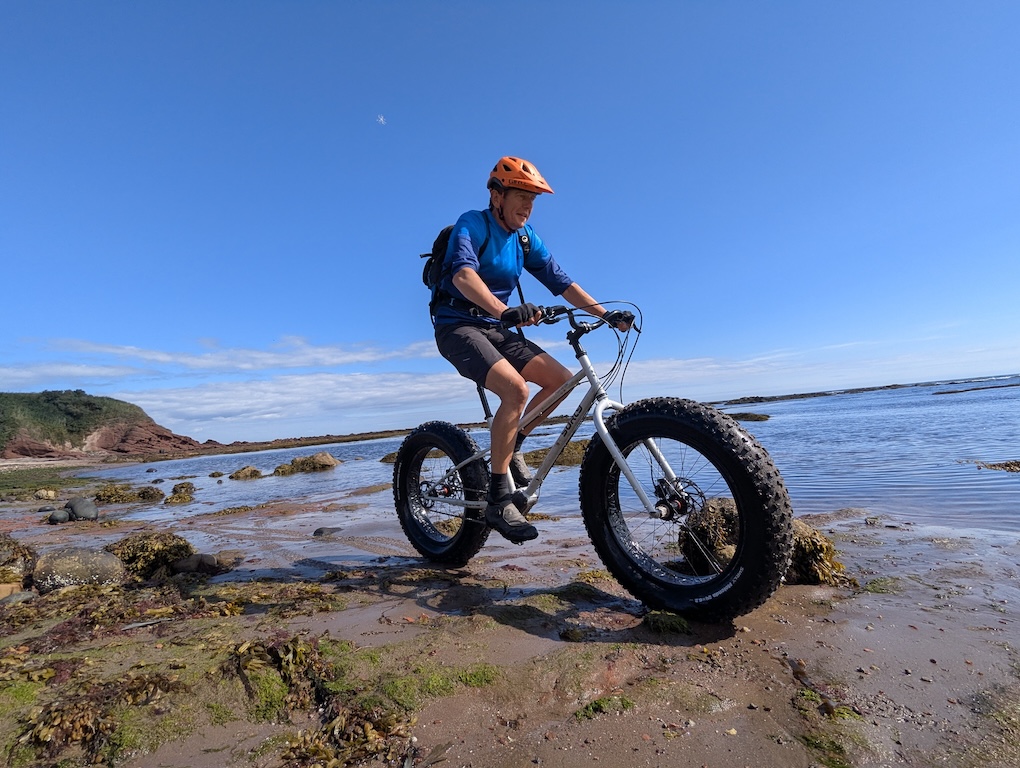
The bicycle industry has always been slave to the maxim that improvement only comes through making bikes lighter and faster. For longer than I can remember, we as customers have been sold the notion that innovation only comes in form of high tech gadgetry and the application of new wonder materials.
You might be forgiven for thinking that a carbon, lightweight e bike is the very pinnacle of the sports development; that innovation comes only in the form of cutting edge design cues borrowed from the likes of the aerospace industry and Formula One.
Latest Singletrack Merch
Buying and wearing our sustainable merch is another great way to support Singletrack
To which I politely say bollox.
There are a whole raft of innovators out there who quietly go about their business without any of the marketing whizz bang, everything must be aero nonsense. Think Bruce Gordon, arguably the Godfather of 29er or Geoff Apps with his Range Rider bikes. To this list, I would add Surly.
‘What, the left of field company stuck in the past of rigid steel bikes, that Surly?’ I hear you cry. Bear with me. As a company, Surly have been ahead of the curve and either created whole new niches (29 plus, 100mm rims, trail fat bikes) or popularized niche designs (fat bikes in the form of the Pugsley, the first large scale production fat bike, the Straggler as a wide tyred gravel smasher or the Karate Monkey as an off the shelf 29er when the rest of us were still riding 26 inch wheels).
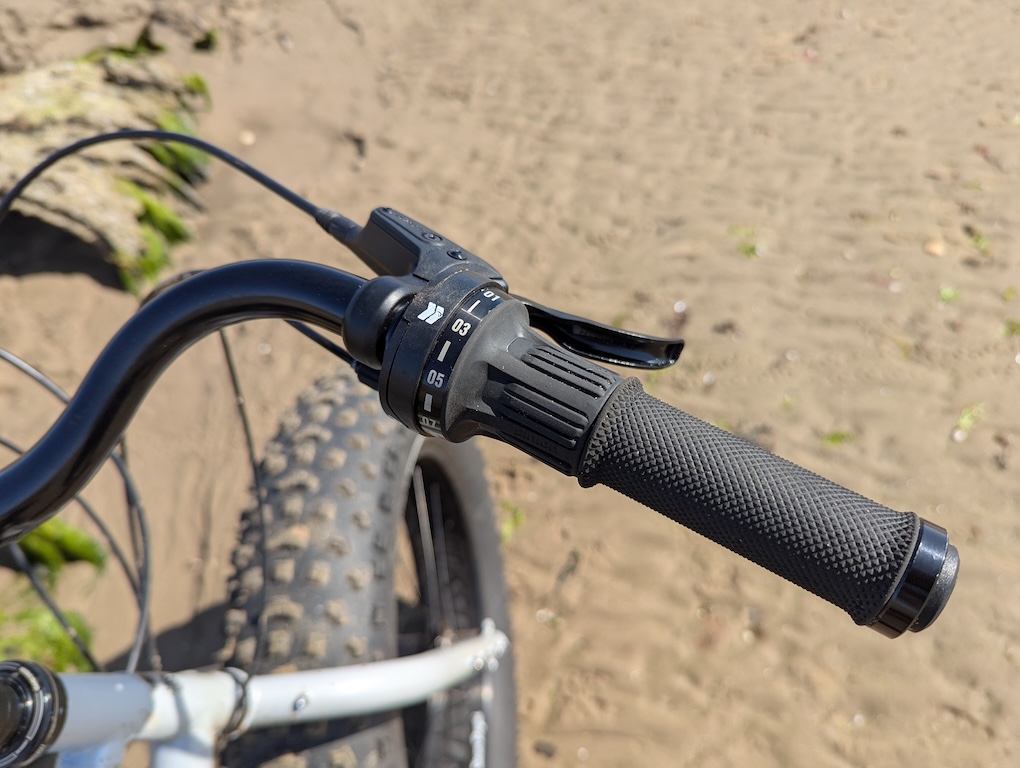
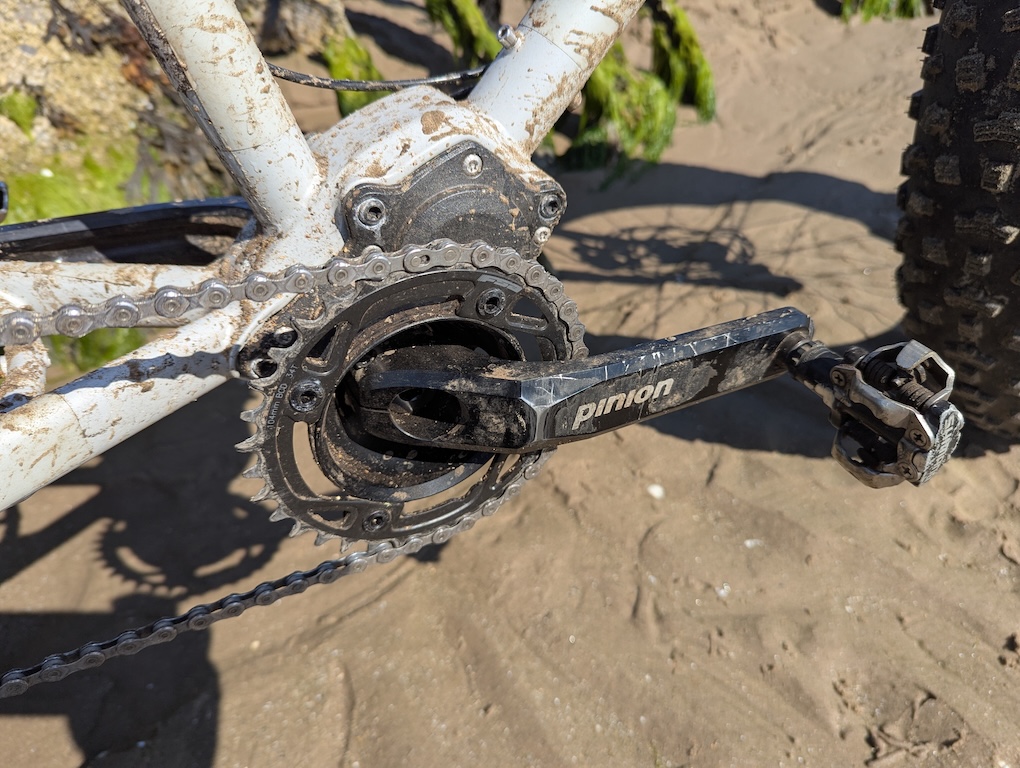
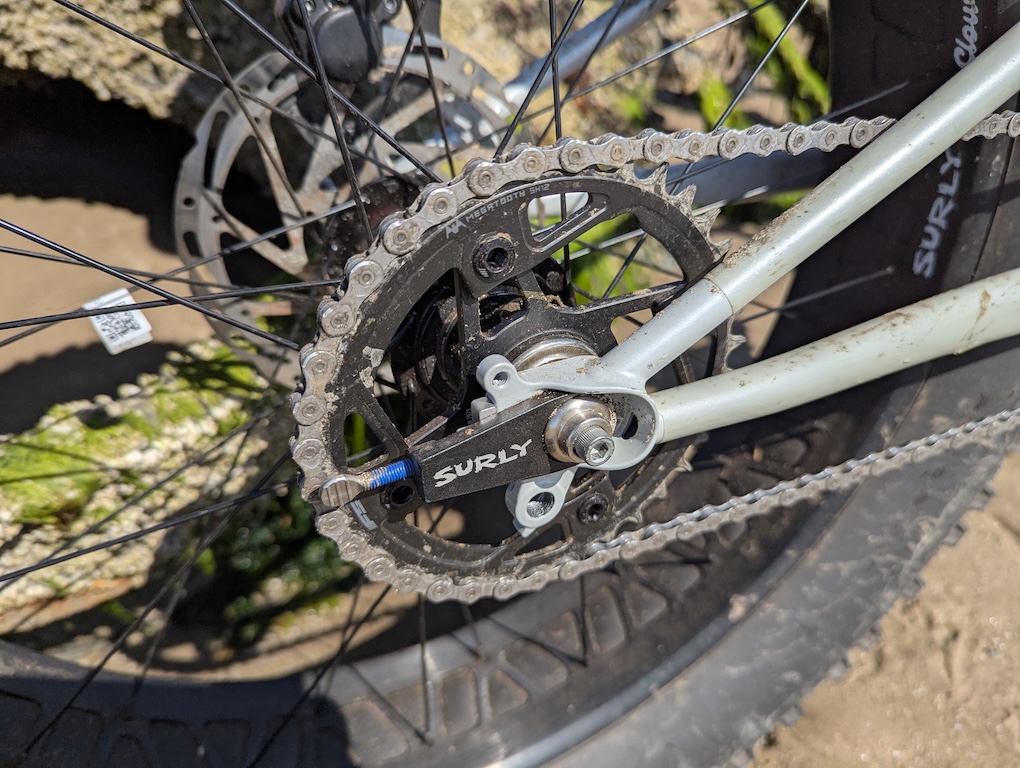
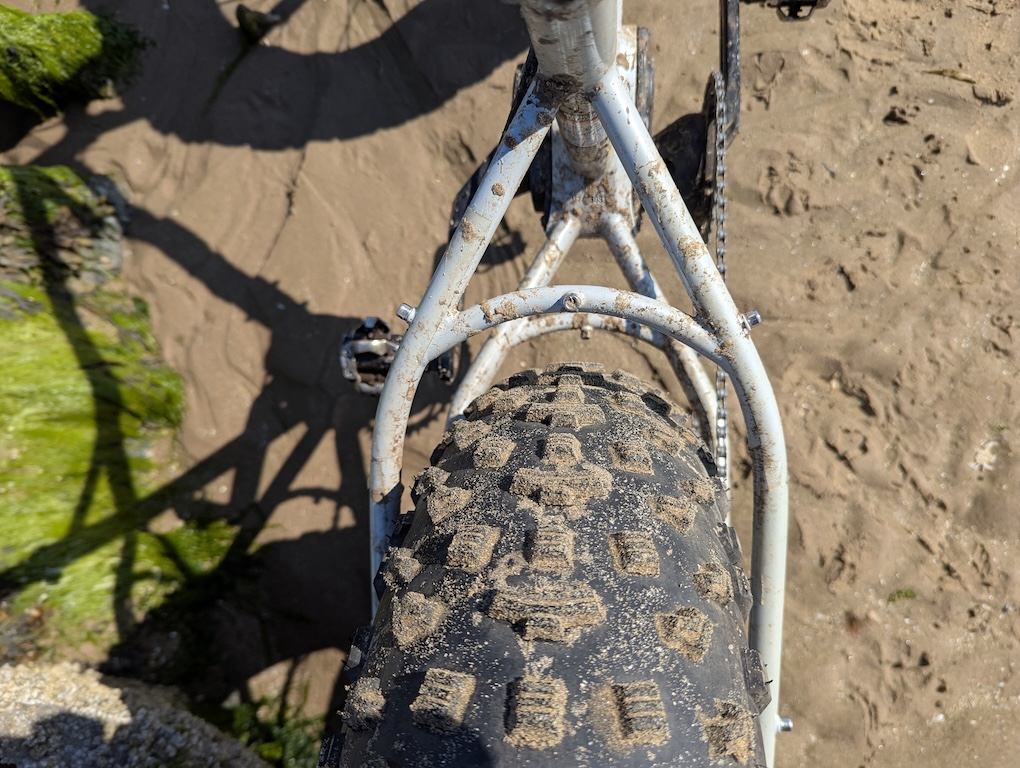
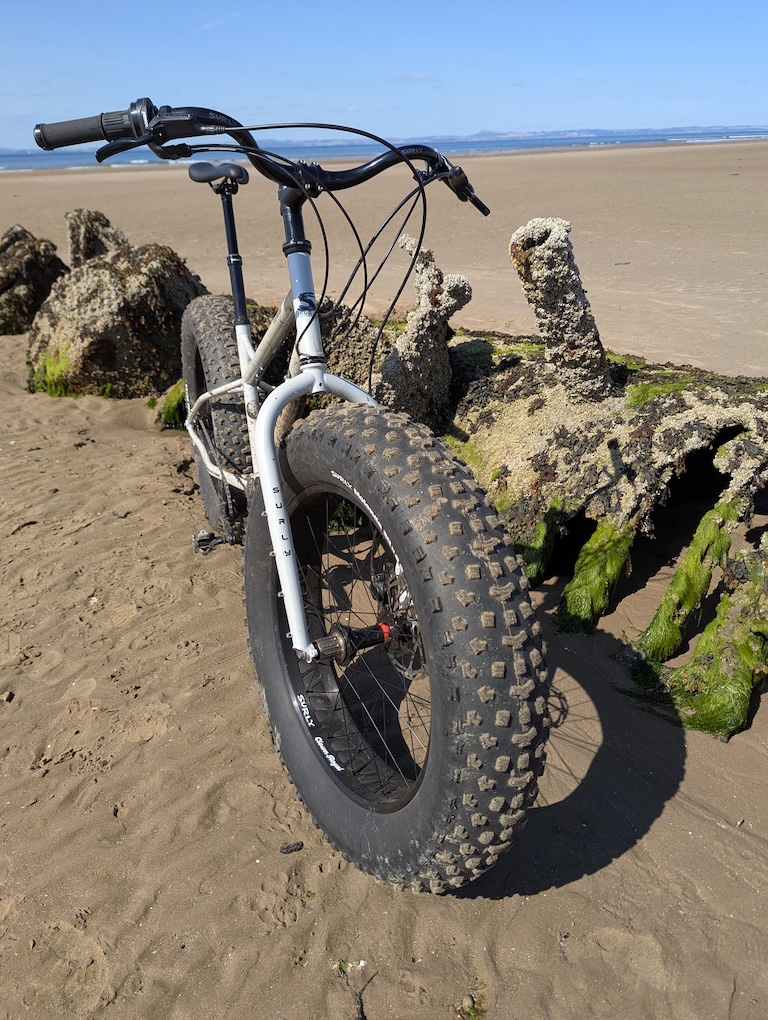
Never ones to sit on their laurels, Surly turned the dial up to eleven again with the launch of the Moonlander last autumn and I was the lucky fellow who got one of these rarer than hen’s teeth bikes to test.
A well kent name in the Surly line up, the Moonlander went on something of a hiatus for a few years. With its offset fork and rear end, it was a big tyred bike that could run regular 135 mm hubs. Version 1 represented a step change in fat bike design and begat the evolution of the trail fat bike in the form of the Ice Cream Truck, a bike I have owned and ridden for the last decade and absolutely love.
When Moonlander 2.0 was announced, I was intrigued to see what Surly would come up with. I heard rumours of massive tyres and whispers of a gearbox but it was only when I got my hands on one in the flesh that I realized that Surly had a potential game changer on their hands. And for me unquestionably the biggest bike which I have ever swung a leg over.
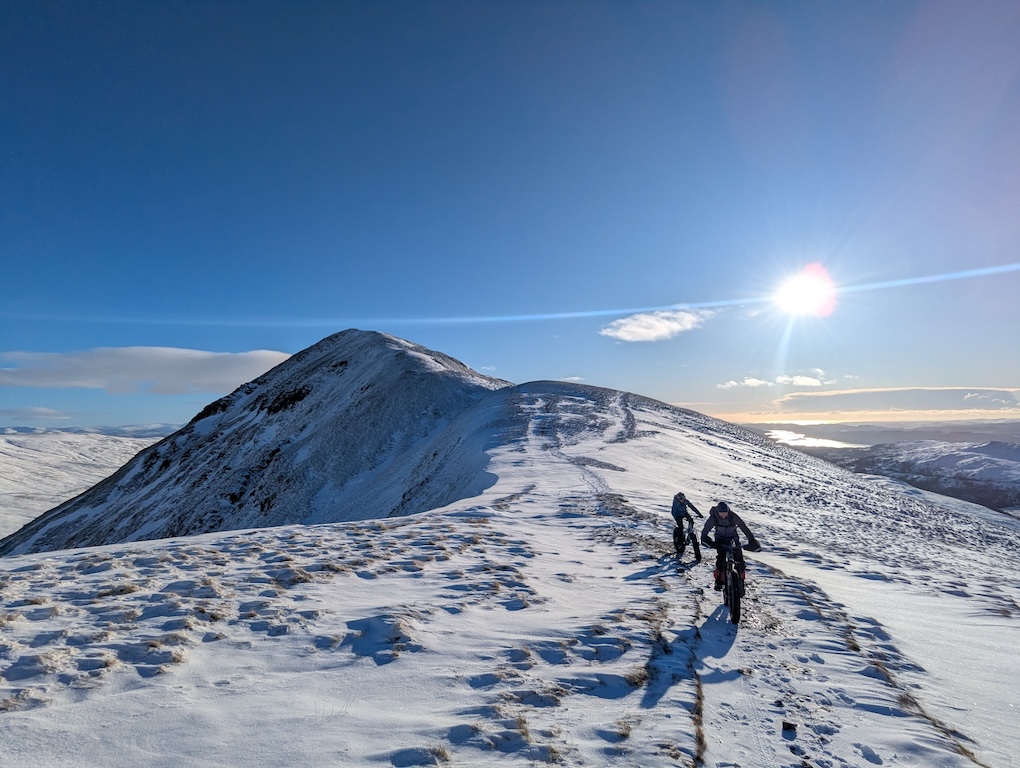
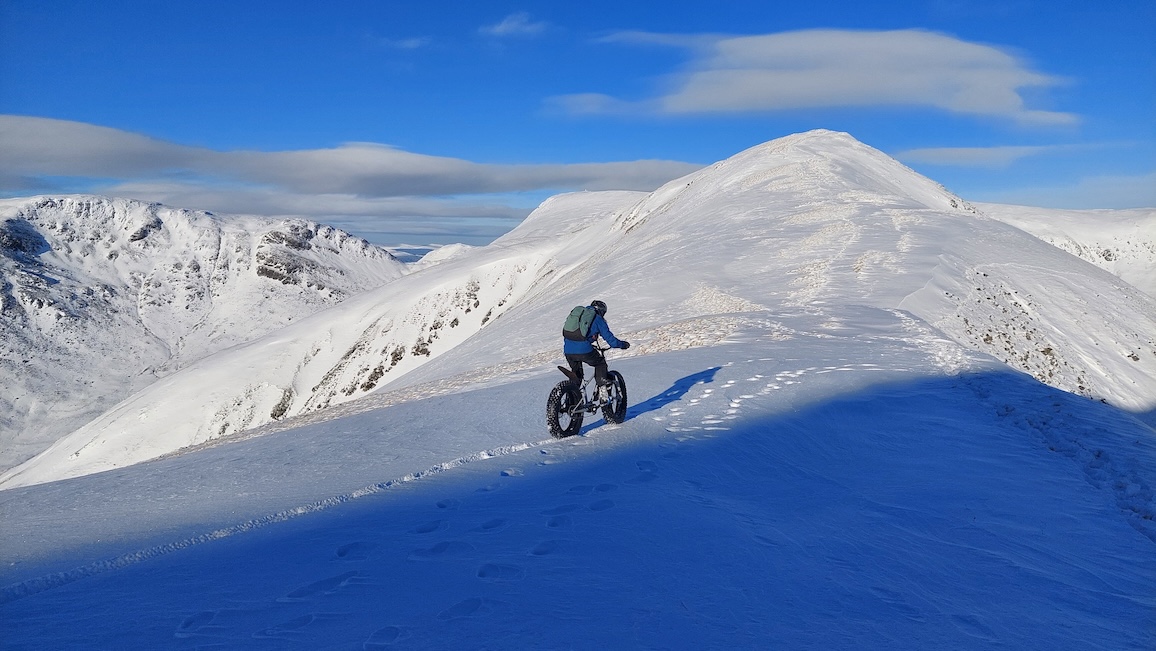
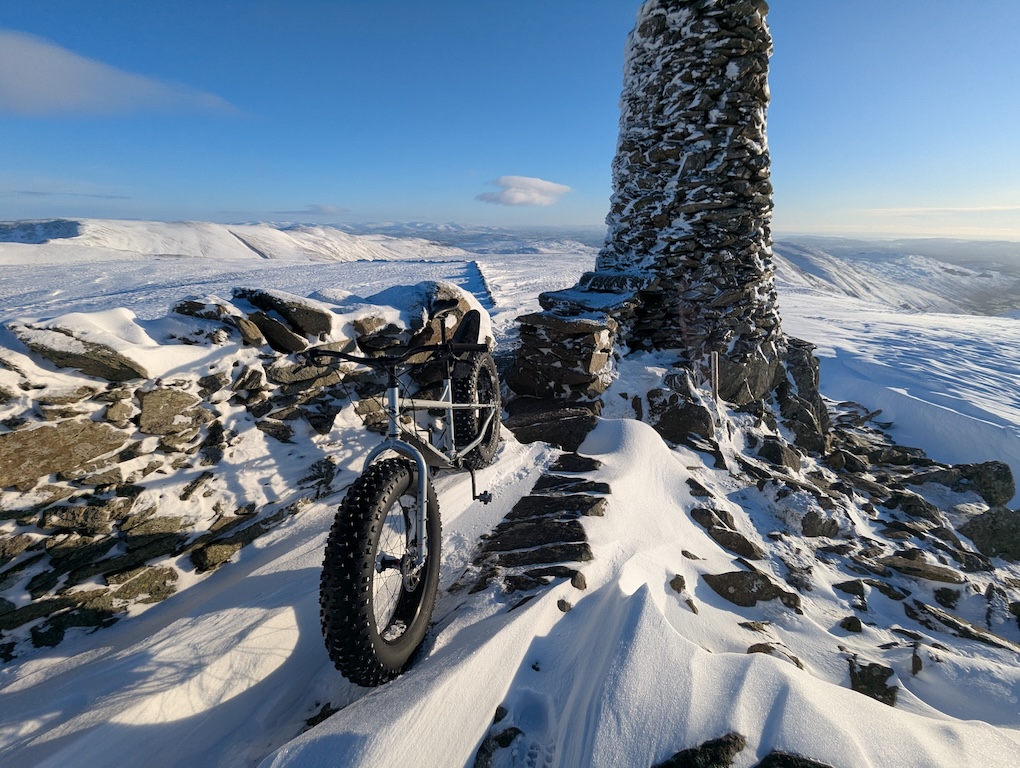
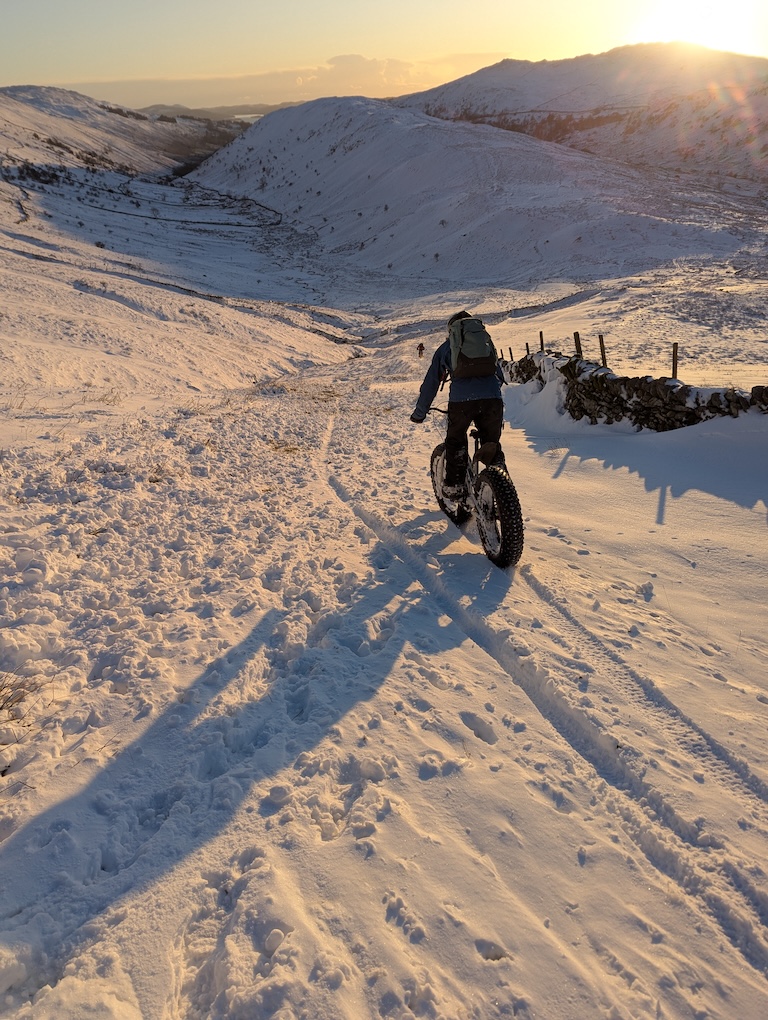
What the heck is that you are riding?
At its heart, the Moonlander could be described as a fat bike but to be frank, that simply does not do it justice. There is absolutely nothing conventional about it.
The very first time I laid eyes on shots of the prototype back in January 2024, I made it my personal mission to get my hands on one. It’s rare that a bike will come along that gets me properly excited but the thought of 6.2 inch tyres does that to someone who was invited to the fat bike party and never left, long after the lights were switched on and the chairs were put up on tables.
In order to build a fat bike that could accommodate such enormous rubber, Surly had to design an entirely new frame from the ground up. Starting with the frame, they adopted a long tail design as there was no other viable means of getting such a large wheel and tyre set up into a frame unless you wanted to end up walking like John Wayne.
Built using Surly’s own brand 4130 Cro Mo steel, the frame is internally treated to resist corrosion which is a big plus for a bike that is likely to see a lot of beach action. The top tube is radically dropped as a design nod to the kind of extreme grind riding that the bike will no doubt get used where you are never quite sure just how soft the ground you are riding over may be when you inevitably foot dab.
If you are a fan of frame bosses, there are more on the Moony than pretty much any other bike out there so you can go mad adding all manner of weird and wonderful kit carrying options.
In terms of wheels, Surly have adopted a 197mm axle width for both the front and rear and used two rear Novatec hubs instead of a front and a rear. This is a first for me but I really rather like the concept of being able to fit a smaller or larger cog to the rear hub to play with gear ratios and the built in epic expedition redundancy of having a spare rear hub available if the back one fails. I’ve been through a few fat bike rear hubs over the years so was quite taken by it.
The showstopper of the design comes in the form of the rims and tyres. In order to maximise the tyre footprint, Surly designed a brand new 100mm rim called the Clown Royale. Ostensibly the offspring of the now discontinued Clown Shoe, the Clown Royale bucks the trends for bigger rims and comes in a 24 inch size.
To complement the rim, Surly developed the 6.2 inch Molenda which is akin a Surly Lou fat bike tyre which has been supersized. Up close (and even when you are far away), they are absolutely massive. If, like me, you have been used to riding a 4.8 inch fat bike tyre, the Molenda makes them look like an ultra-lightweight cross country tyre.
If you want a sense of scale, on a ride along the sands on the East Lothian coast, I came across a front tractor tyre which was the same width. Yowza. If you feel the need, there is clearance to run pretty much any fat and plus size tyre set up but for me, the whole point of the Moony is the enormous tyres.
Not content to just create big tyres, Surly have gone all in and embraced a 9 speed Pinion gearbox with a gear range of 568%. Eschewing a traditional derailleur set up, this design choice reflects the intended use of the Moony. Think exposed bedrock, soft sandy beaches, rocky dunes, heather laden trackless path, snow – the places that you would be loath to even try and ride a normal bike. That said, there is the option of adding a rear mech if you decide that you want to go a bit mad(der) and create an 81 speed monster.
In terms of the finishing kit, braking is taken care of by a set of Tektro HD-M285 hydraulic disc brakes on 180mm 6 bolt rotors. A 125mm Trans X Dropper (100mm on the small) and a WTB Volt saddle take care of your hind end while up front Surly’s own Terminal bar with radical back sweep is coupled with Velo Lock On grips.
The headset is a Cane Creek Forty which in inch and an eighth guise looks completely at odds with the aesthetic of the rest of the bike. It looks almost weedy compared to the rest of the bike but functionally, it performed flawlessly throughout the test period.
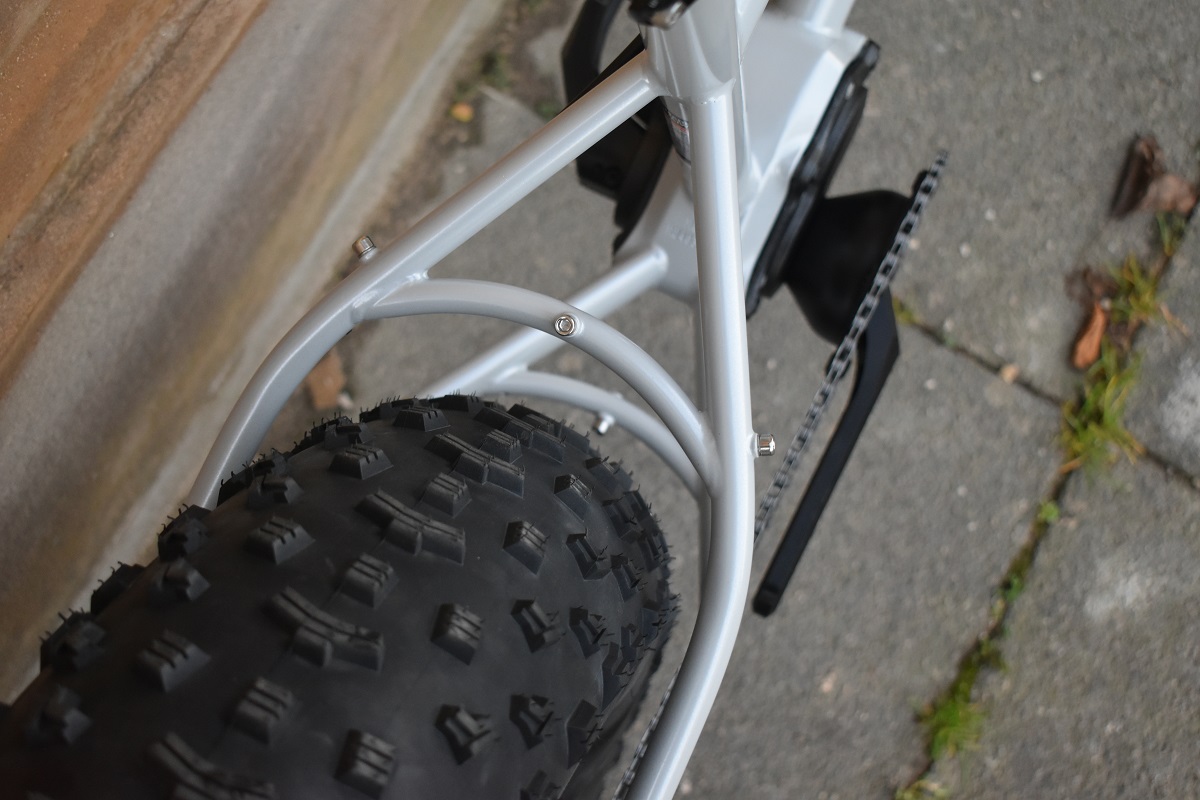
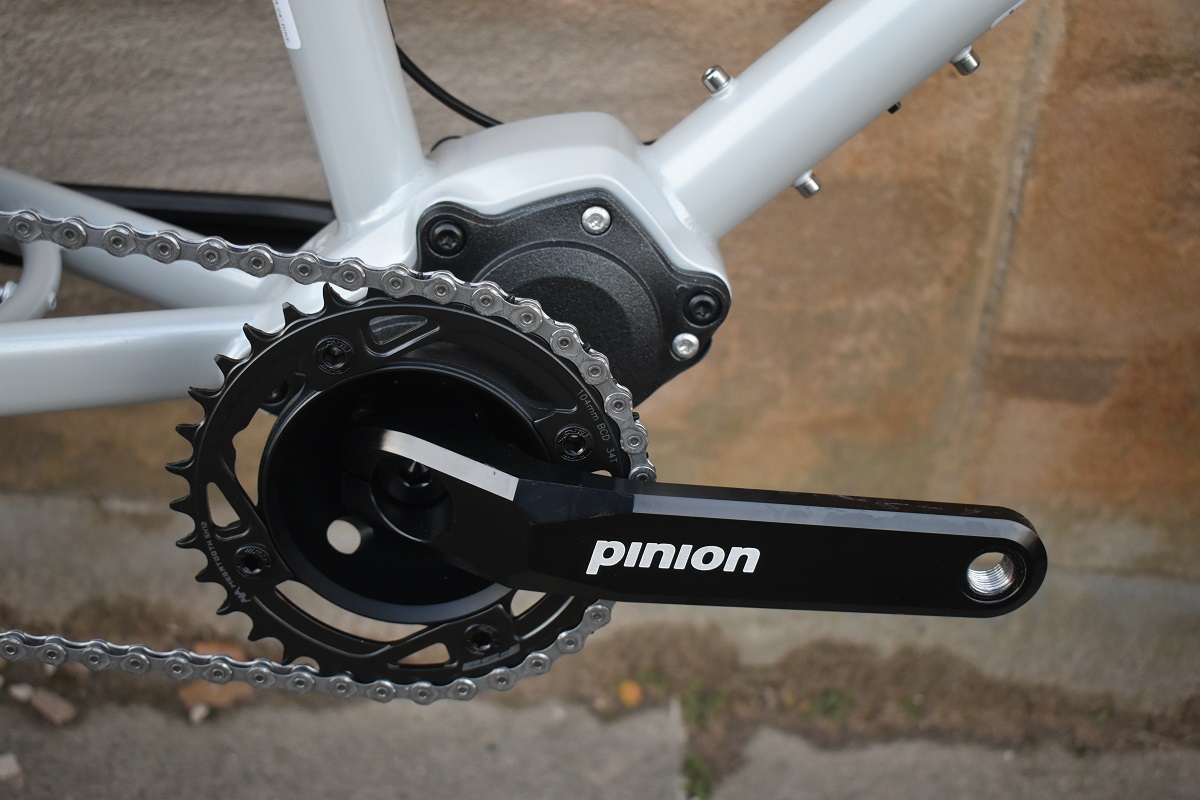
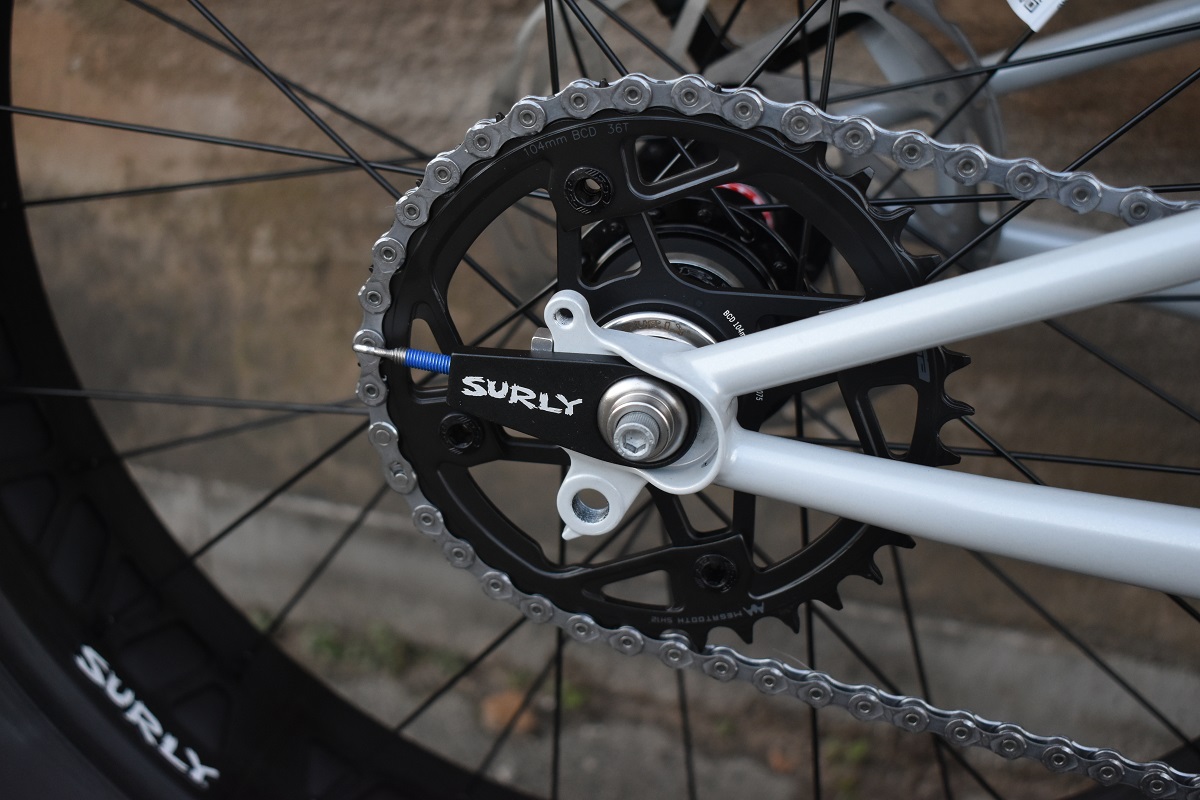
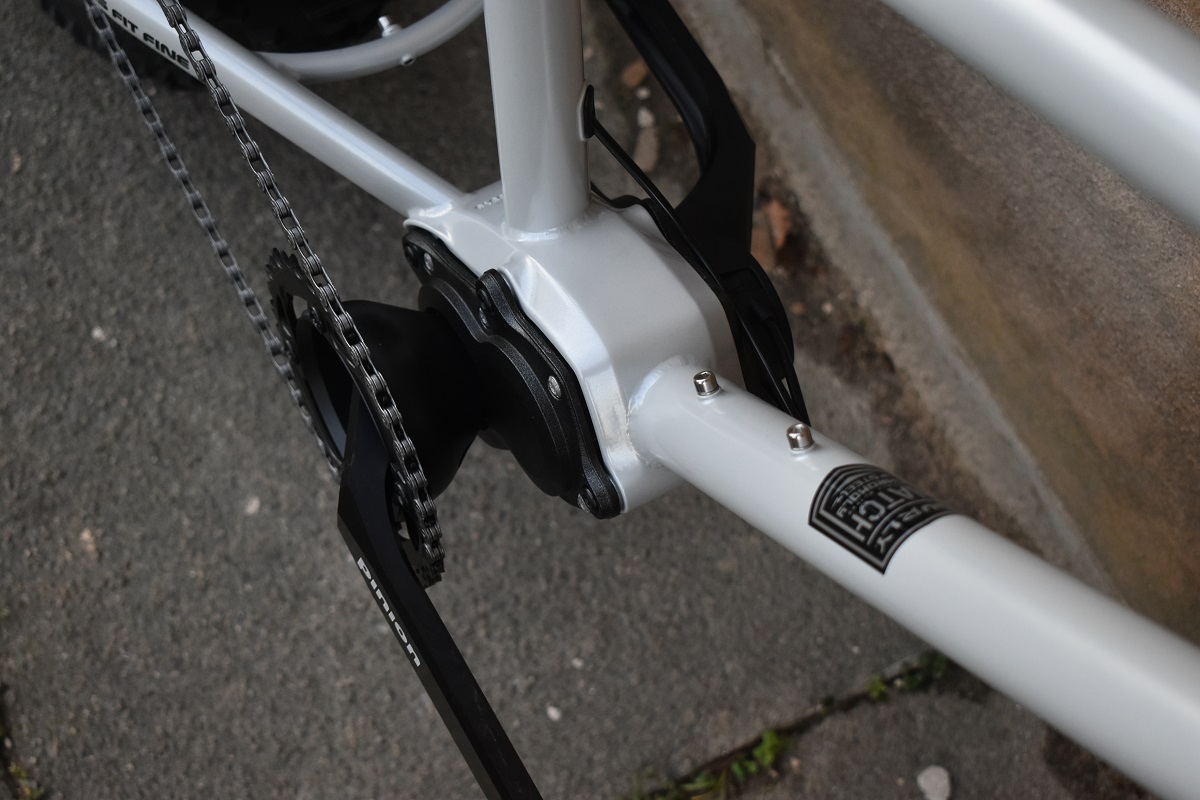
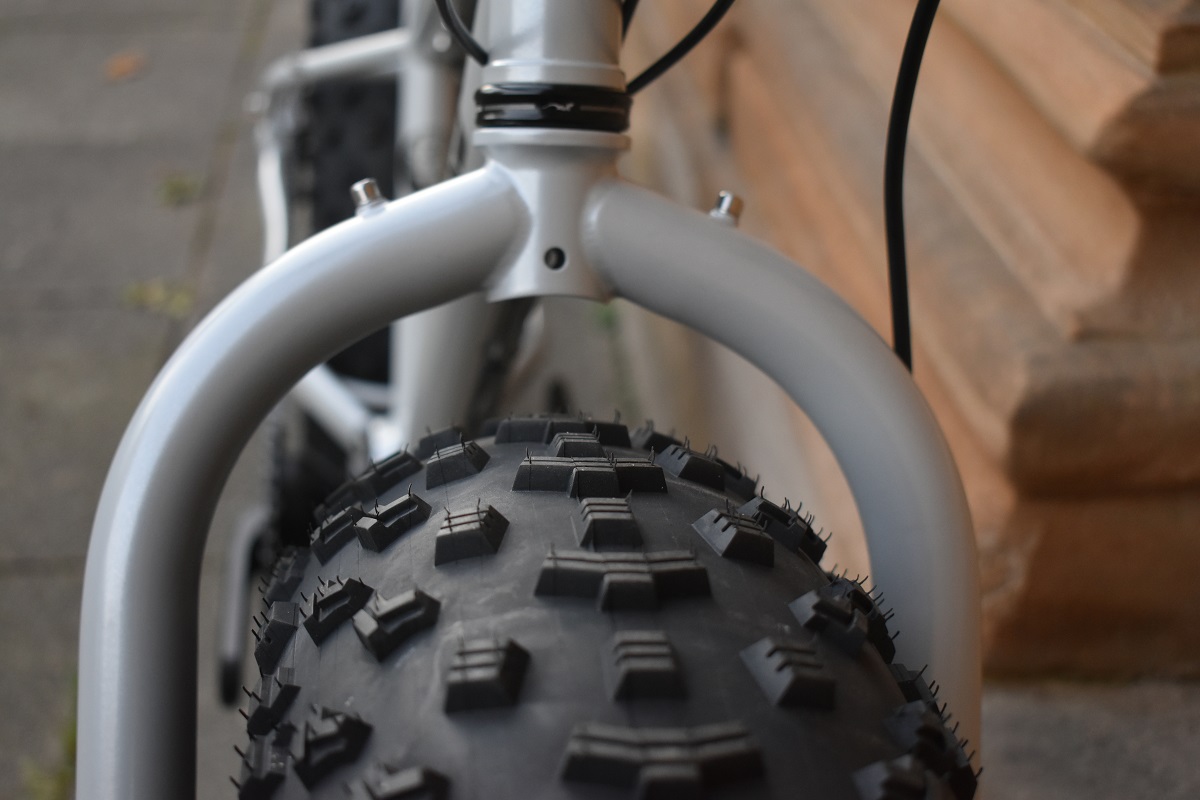
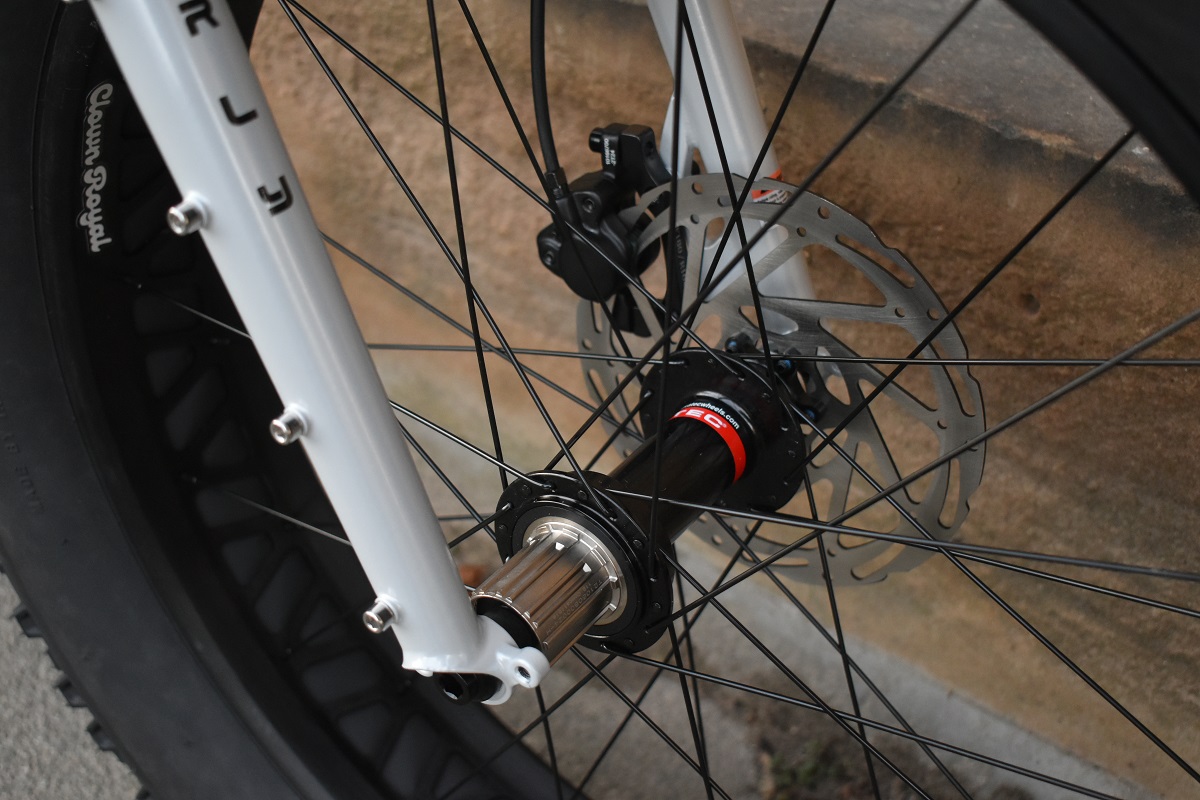
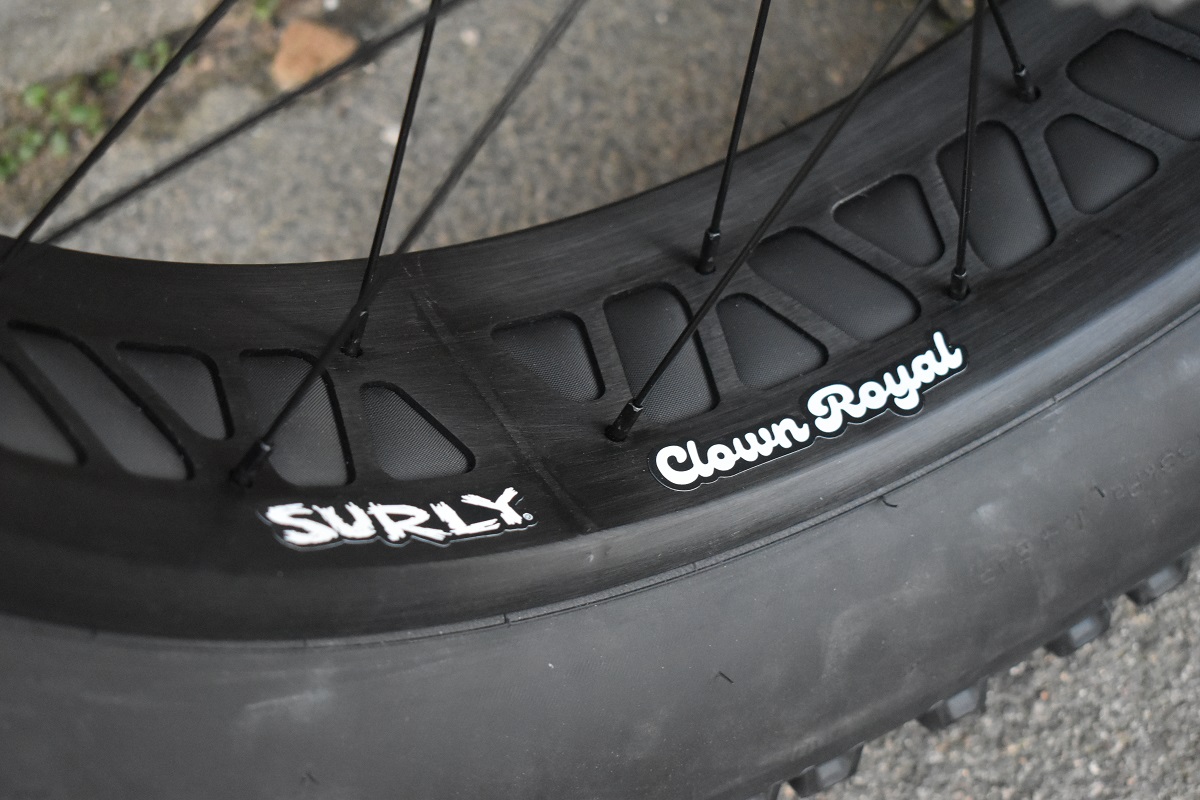
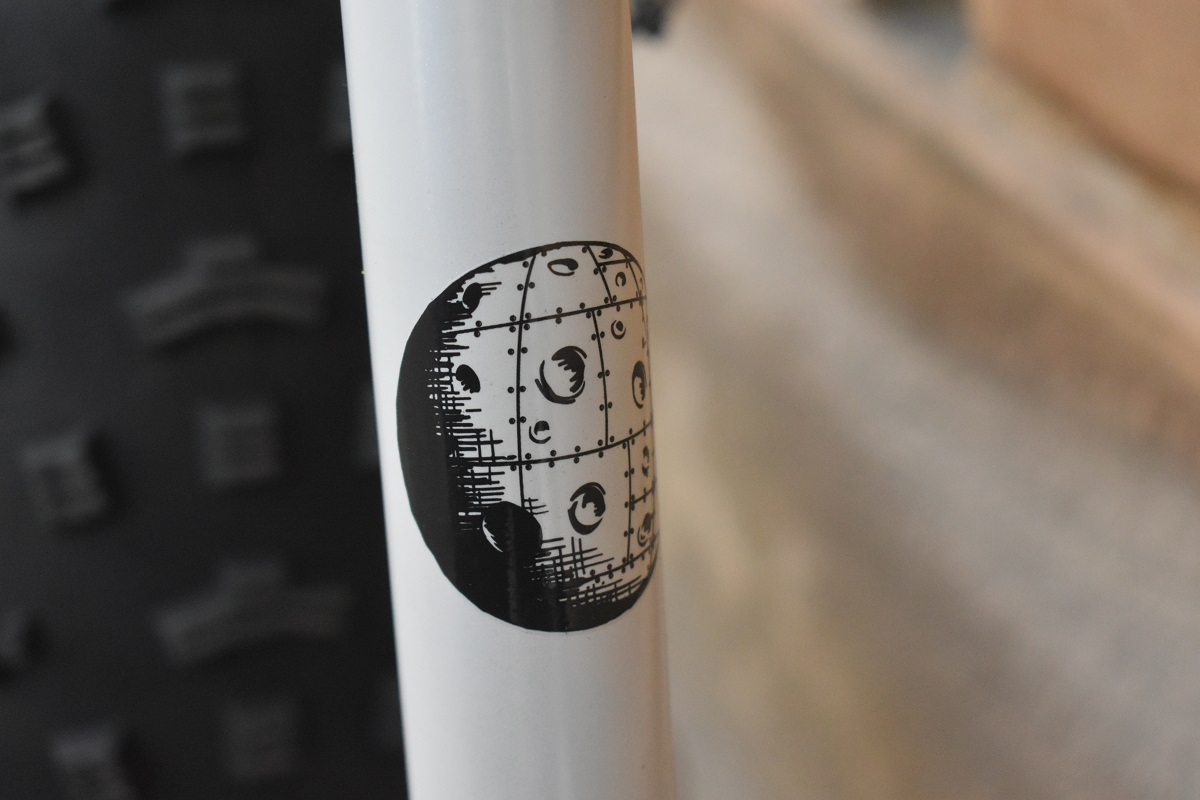
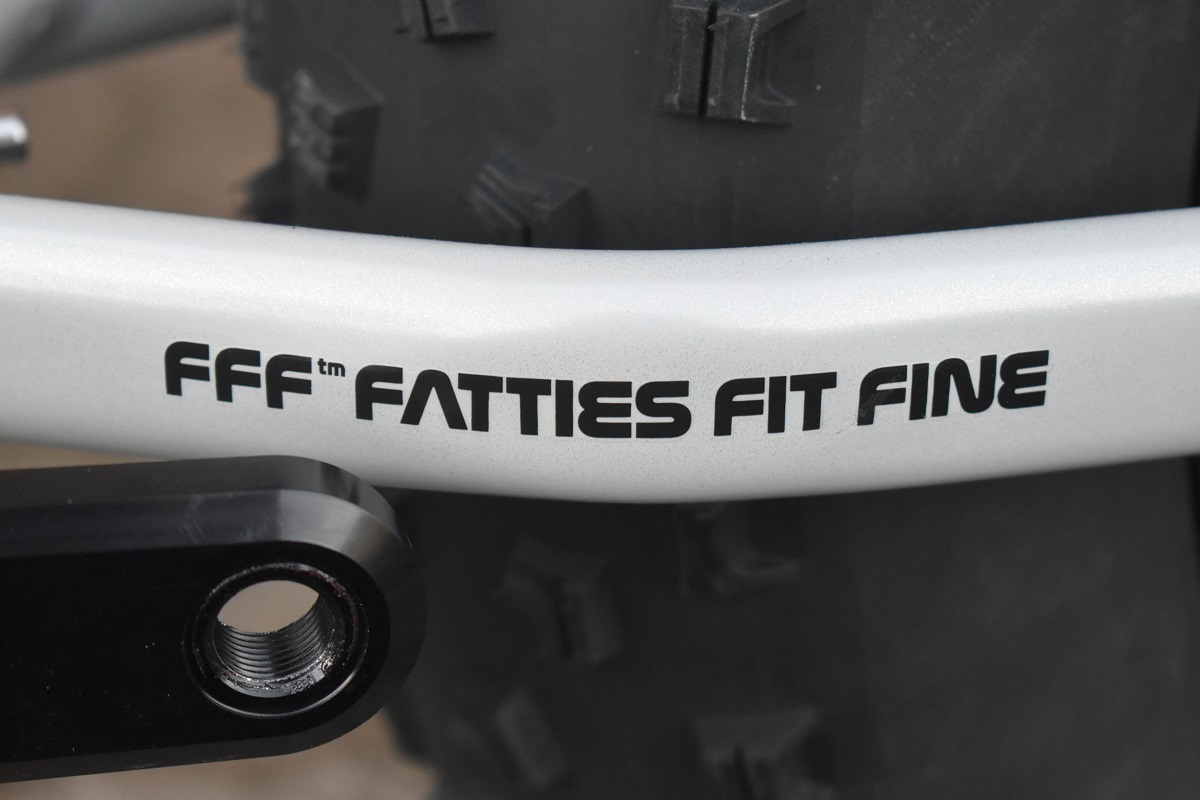
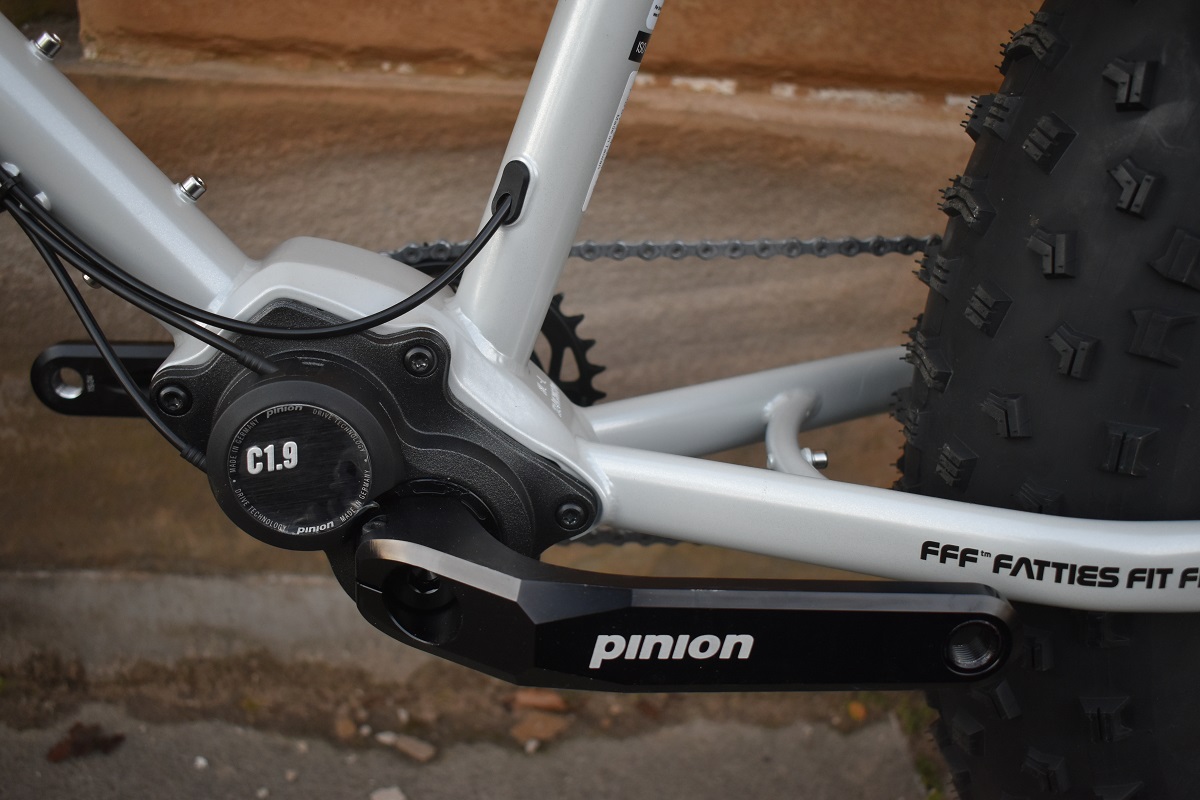
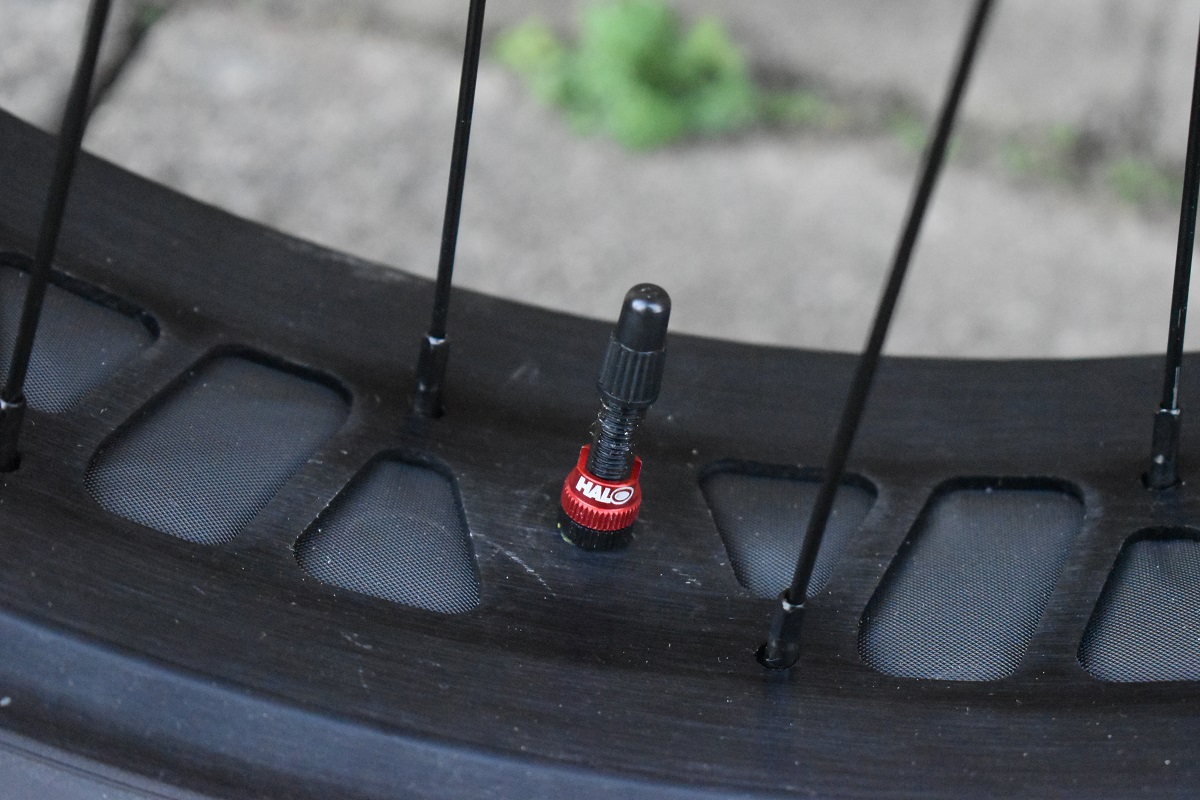
Geometry, Schmeometry
In the size large tested, the top tube measures 25 inches with a stand over of 31.22 inches. Reach is 17.48 inches and stack is 24.61 inches. Centre to top seat tube length is 18.9 inches while the chainstays are a whopping 22.13 inches. No super short, tight back end here, no siree! All this combines to give a not inconsiderable wheel base of 50.39 inches.
Finally, the head tube is 68.5 degrees and the seat tube is 73 degrees. Think of it as hugely long, definitely not low and a long way from slack. Oh and for those who think it matters, you better be working the upper body if you have to lift its 47 pounds over a gate or fence. Light, it ain’t!
At a bit over 6 foot 1, I felt immediately comfortable on the Moony. My preference is for bikes that are more upright than low, low and slack. Coming from a Jones bar equipped Surly Ice Cream Truck, the Moony did not feel a world away in terms of ride position. It has a definite heads up, upright feel to it which I really like.
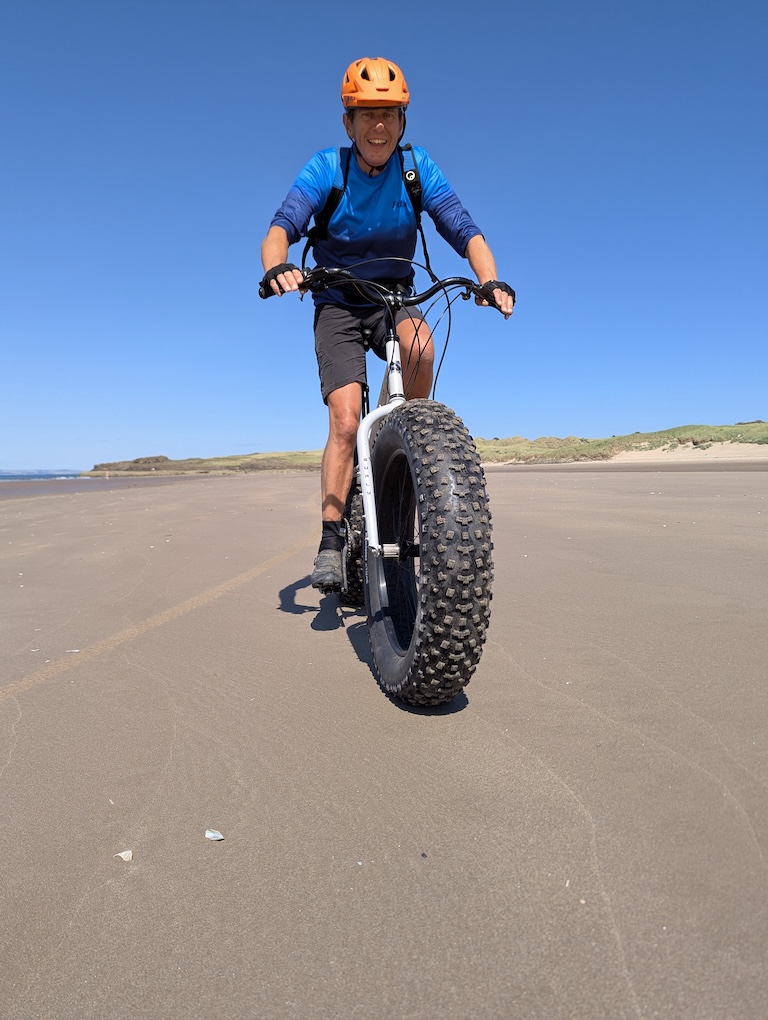
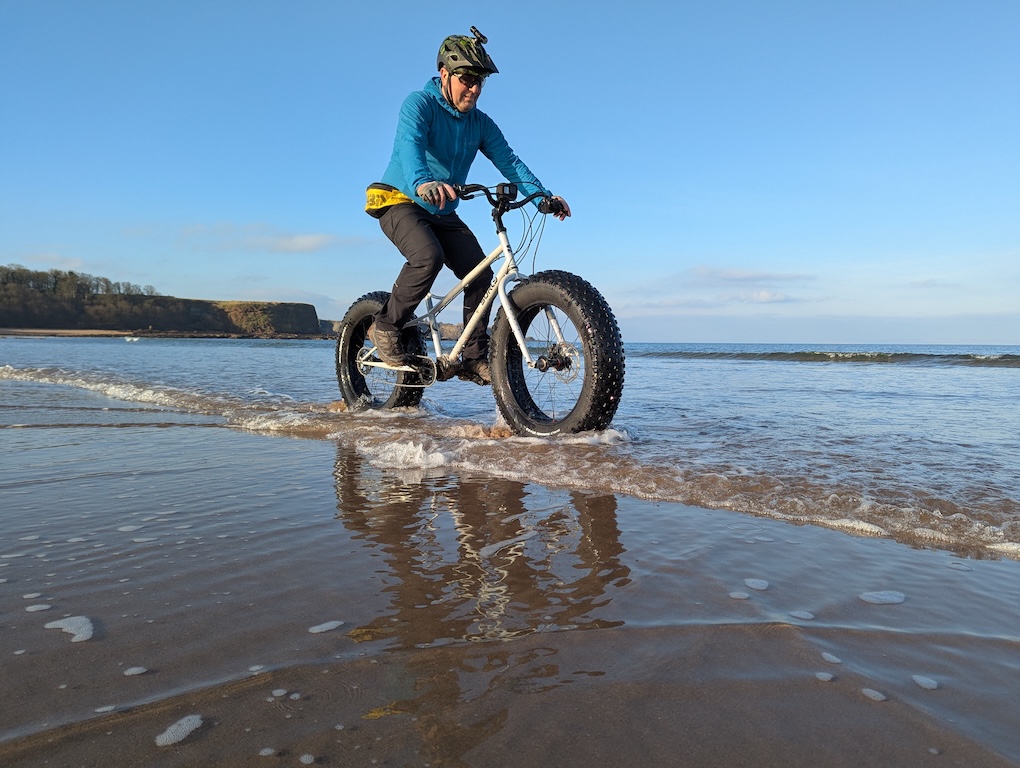
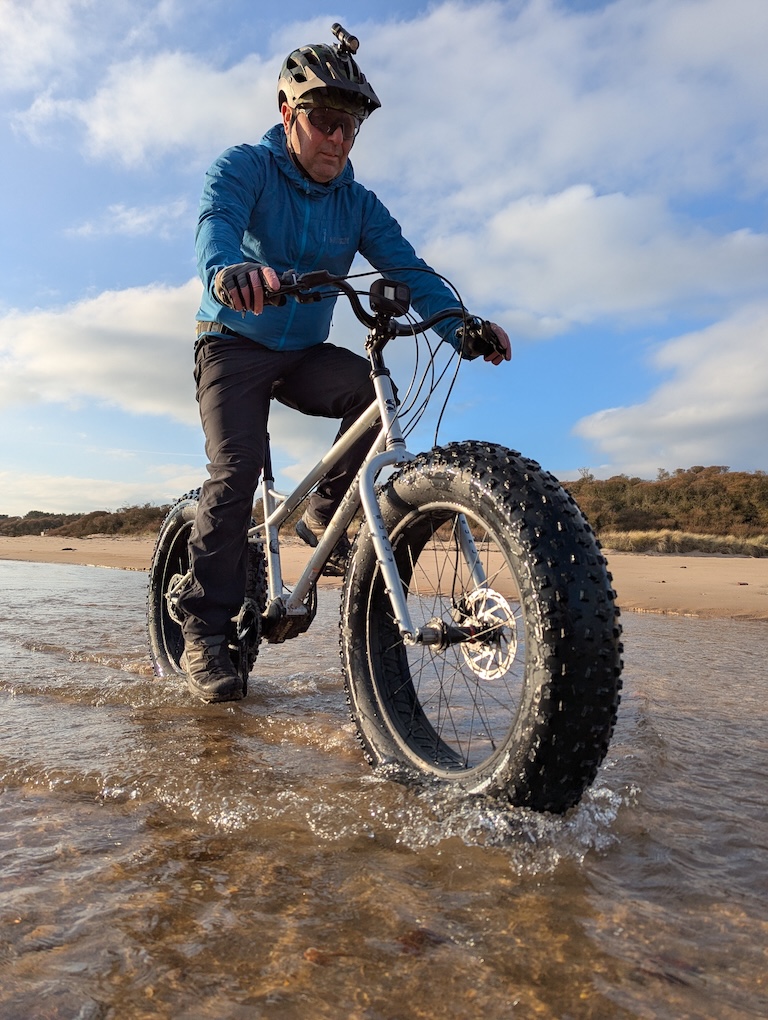
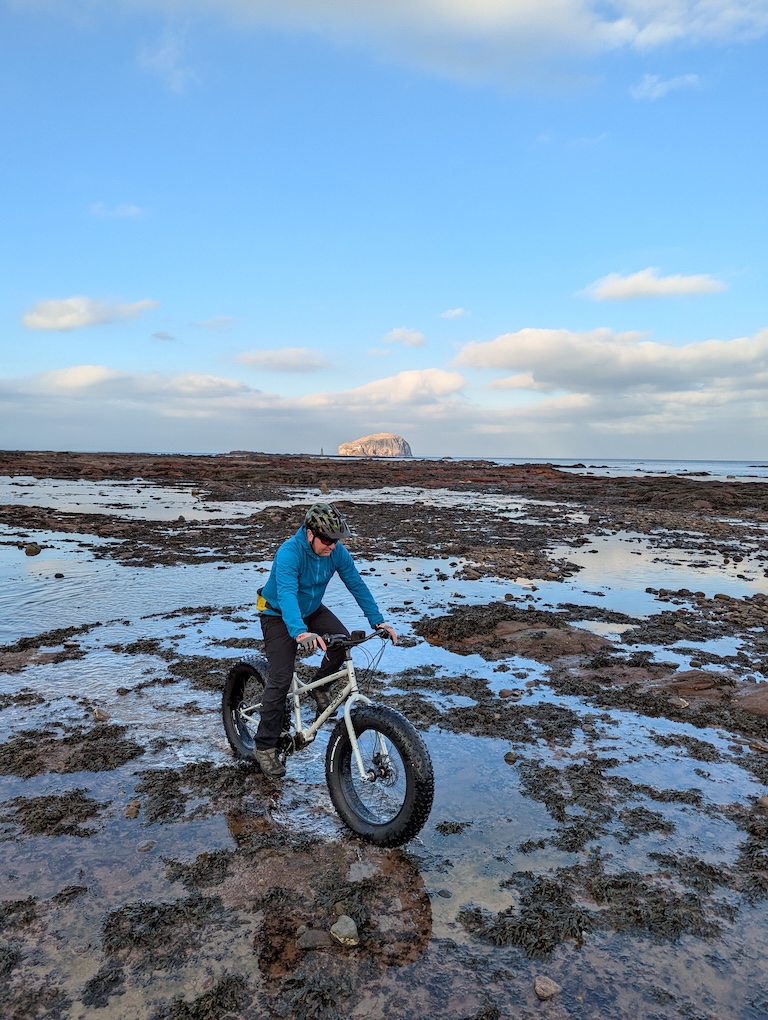
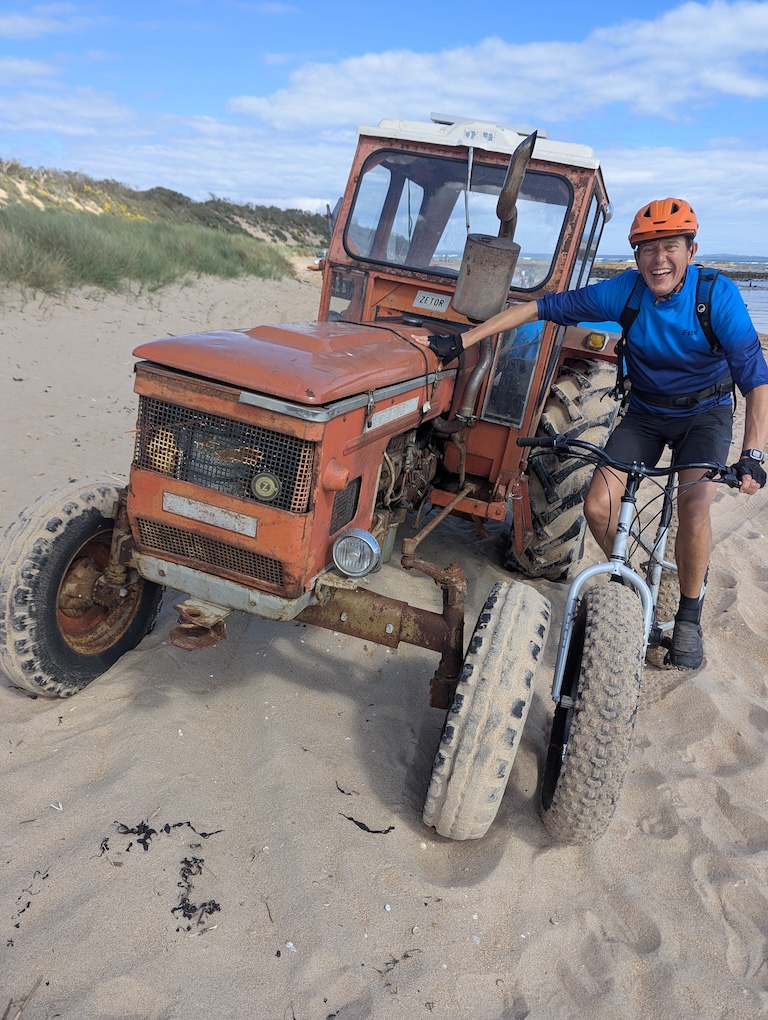
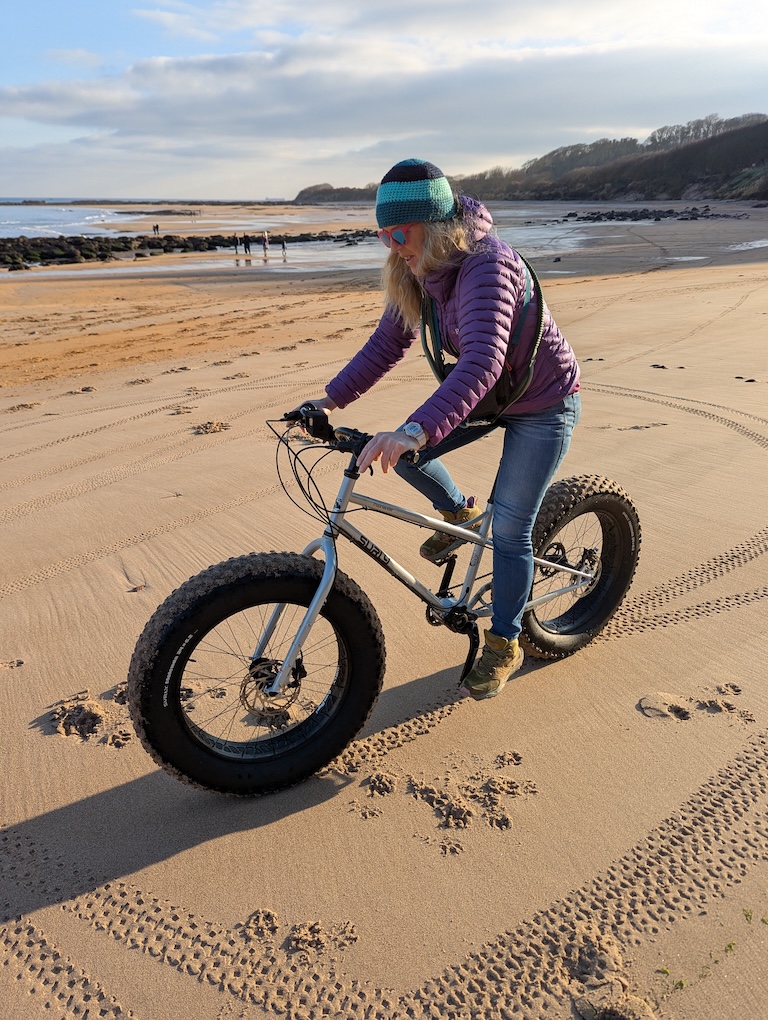
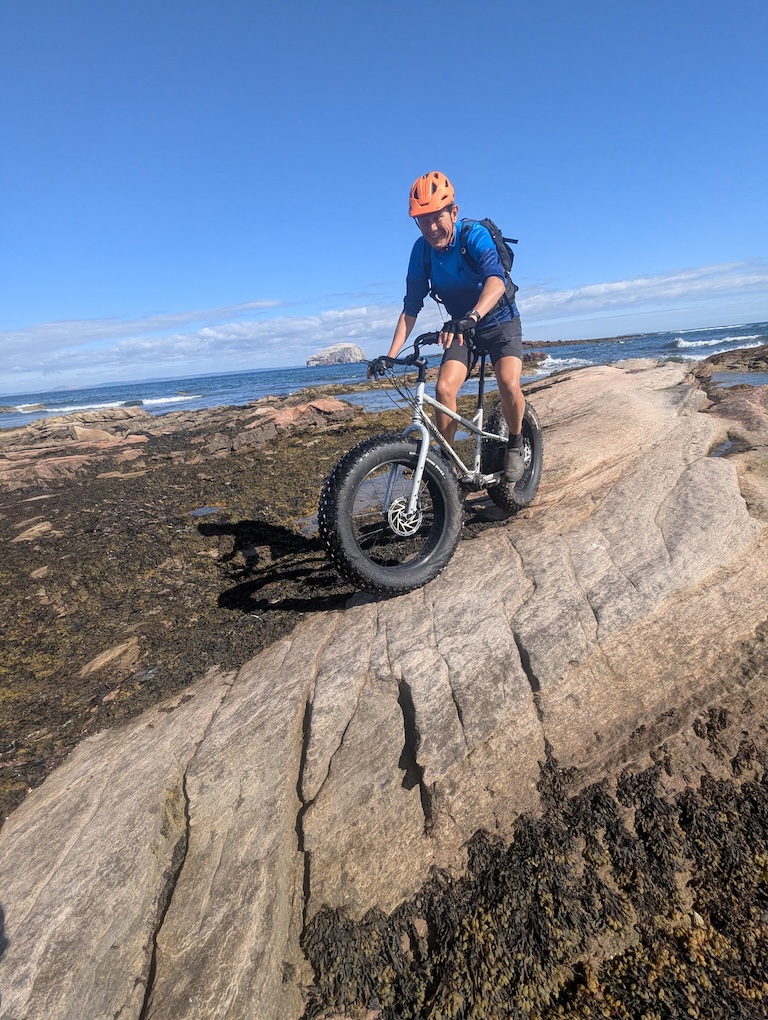

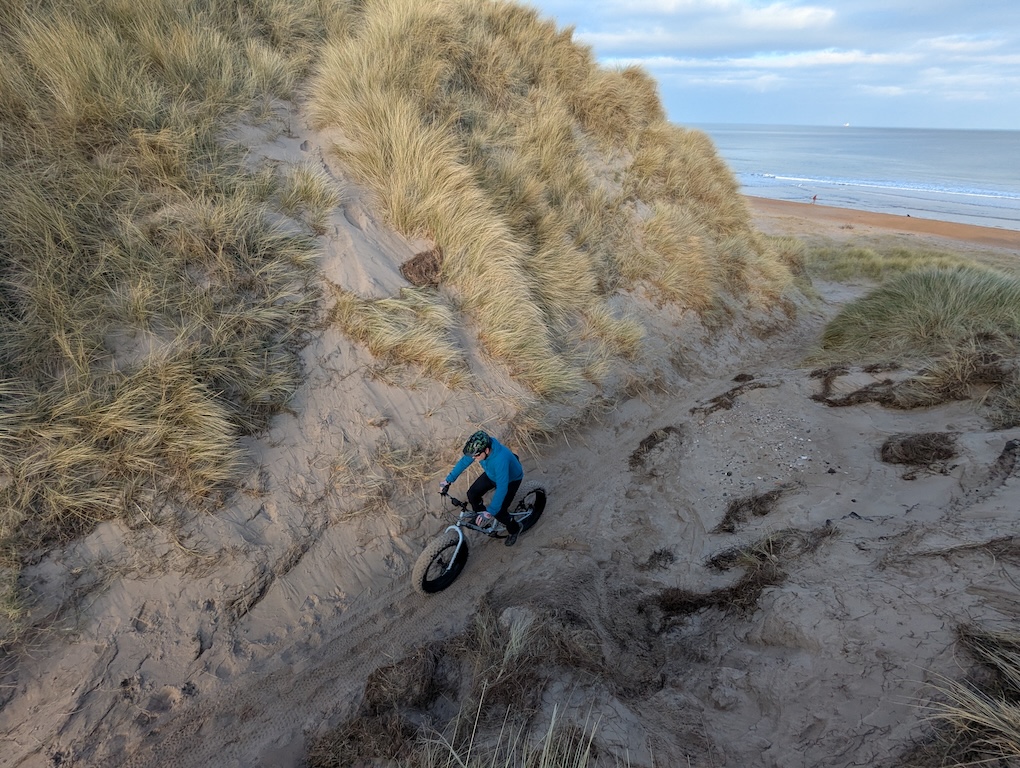
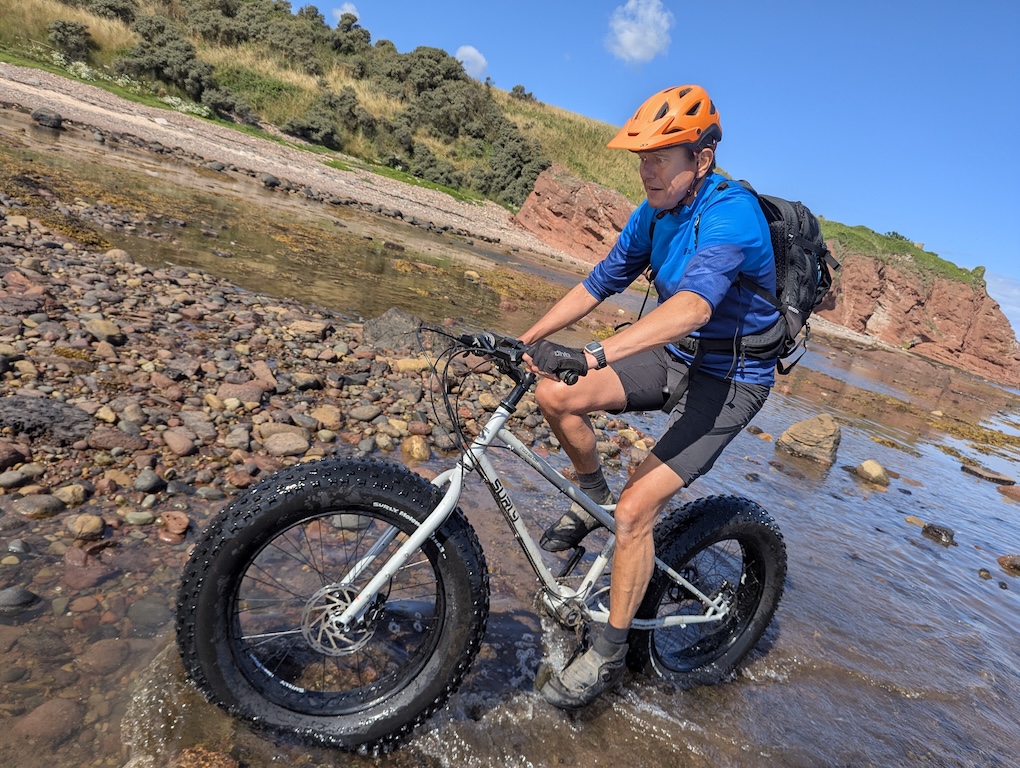
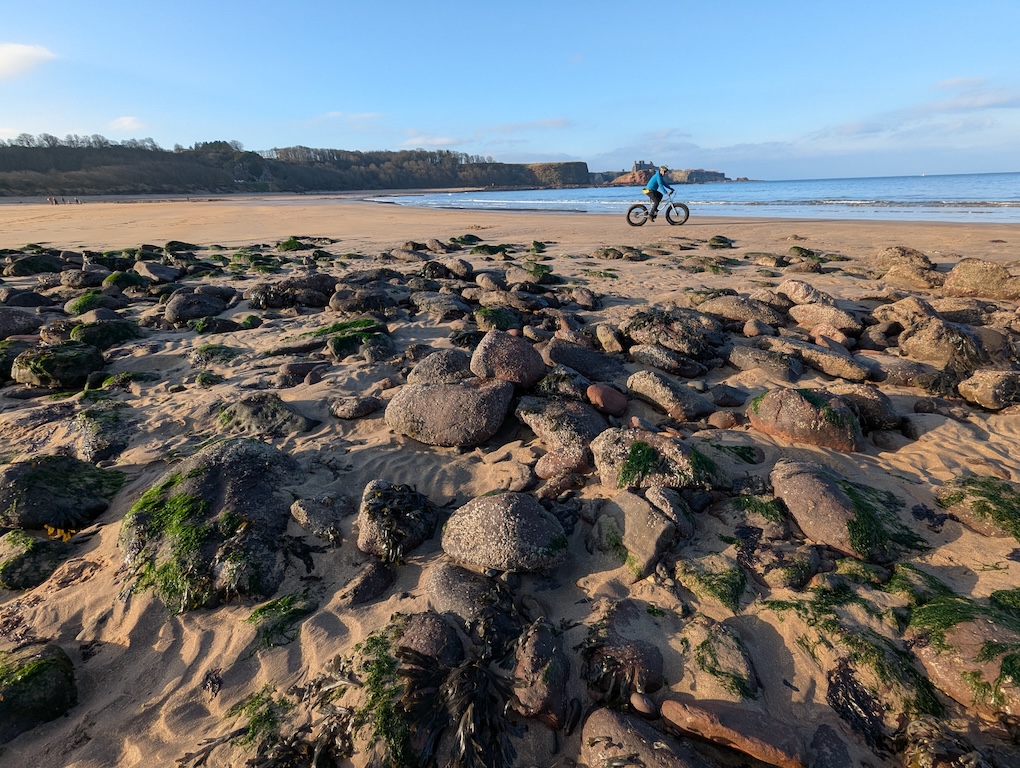
Enough with the yadda, yadda. How does it ride?
From the get go, if you ride a Moony, prepare for lots of questions from cyclists and walkers alike. There is nothing shy and retiring about this machine so if you are a people avoiding introvert, look away now.
Riding it for the first time on a shakedown ride round the streets and trails where I live, I was inundated with quizzical looks and friendly questions. It is the kind of machine that people see being ridden and start to grin. It is a conversation starter and a great way of breaking down the barriers which so many of us put up in modern life. At over 31 inches tall and 6.2 inches wide, the wheels literally dwarf every other wheel on the road and make a Brompton look like a child’s toy designed to be ridden by their teddy bear.
Slinging a leg over it, I appreciated the low slung top tube. When it comes to rock crawling on the beach, dabs and unplanned dismounts are the order of the day and as such, Surly have nailed the brief. At no point in the test did I experience any unfortunate Chalfont / top tube interactions.
Turning the pedals over for the first time, once I got past the initial feelings of ‘WTF am I doing riding this beast?!’, I was pleasantly surprised at just how easy rolling the wheel were, despite their not inconsiderable size and weight. With that much mass to rotate, more effort is required to get the wheels turning up to and maintaining speed than on a regular mountain bike.
The noise on tarmac is considerable – I would liken it to a WW2 bomber following you wherever you go. On the plus side, you need never use a bell again as everyone will hear you long before they see you approaching. You can of course try and play a game of roadie baiting, chase and draught but in my experience, you will not be maintaining your maximum watts for very long. The phrase breathing out of one’s arse being entirely appropriate here.
If speed is your main concern, this is not the machine for you. Rather, the Moony is a machine that not only benefits from but encourages you to ride more slowly. Chris Boardman once told the Tour De France commentator Ned Boulting that the easiest way to deal with riding into a headwind is to go slower. The same applies here.
There is a happy balance to be struck between riding for several hours and not blowing up through fighting the weight of the wheels. Even set up tubeless (as standard, they come with TPU tubes), my scales positively groaned under a wheel weight of over 5.3 kg including disc and excluding chainring. Slow and steady is the mantra of the Moony. You can try and fight it but you will lose.
We’re going to need a bigger pump
Tyre pressure plays a critical role in affecting how the Moony rides. For soft, sandy beaches and rock crawling, dropping down to around 4 psi felt good to me, offering massive amounts of traction with some bounce. On the road, gravel tracks and singletrack, I upped the pressure by a few psi in order to avoid the pronounced fat bike bounce and fat auto steer that can be quite distracting and annoying. If you are thinking of buying one, a mini track style pump is an essential bit of kit.
The huge footprint and simply vast amount of rubber means that when it comes to rock crawling, the Moony is the best in the business. The long tail design makes for an inherently stable platform which means that you can just concentrate on moving forward as opposed to worrying what the trail ahead challenges you with.
Even compared to the Surly Ice Cream Truck, the Moony floats and grips like no other. I spent a lot of time riding the same trails on the two different bikes to measure the differences. Drop the pressure and you are able to ride farther, faster and more easily than on any other fat bike on beach terrain, whether it be dune surfing, shore spinning or riding through banks of shale and water smoothed rocks.
The nemesis of the beach rider is arguably wet seaweed on rock but on even that, the Moony remains calm and composed. On one ride, I watched slack jawed as the Godfather of fat biking in the UK, Bruce Mathieson aka Coastkid, made short work of one particularly greasy section of coastal bedrock. Only when he stepped off the bike and narrowly avoiding going on his backside did he realize that he had ridden over something that had all the characteristics of wet ice. It is less a case of riding and more just getting on, pedalling and let the bike do all the work.
In snow, the Moonlander again showed its flotation chops. Back in January, I went on a deep snow adventure in the Lake District with Kev of Ghyllside Cycles and fellow fat biker James. It was interesting to see just how much difference the extra 1.4 inches of width over my stock 4.8 inch tyre set up made.
Where the Moony floated over deep snow banks without breaking the crust, the smaller tyres bit through and dug in. Deep, soft, untracked snow still stopped it in its’ tracks though. When riding became pushing, the extra heft of the Moony really made itself felt. It’s not a bike that lends itself in any way to hike a bike, albeit the small triangle between the seat and top tube does double as a handy grab handle.
It is a bit too long and heavy to carry for an extended period unless one is training for an Ultra and wants to overload their muscles.
Gearbox Goodness?
In terms of the Pinion gearbox, it lends itself perfectly to the off the grid aspirations of the bike. However it is not without some foibles. First and foremost, the jumps between gears are noticeable. The gearbox is not like riding a derailleur equipped bike where the changes in gear ratios can feel quite subtle. The jumps are evenly spaced and quite large which is a consequence of the wide gear range. There were times when I changed gear and felt I had to change cadence more than I was expecting.
In order to change gear, you have to back off the pedals which took some getting used to. The upside is that you can change gears while stationary which is useful when slow speed rock crawling. That everything is protected from the elements means that daily maintenance is pretty much restricted to cleaning and lubing your chain.
There is an amount of drag in the system but compared to the impact of the massive tyres, the efficiency impact is marginal. If you are used to trigger shifters, the twist shift shifter might come as a bit of a surprise but I found it intuitive to use with no downsides. It just worked.
With oodles of clearance, the Moony excels in rock gardens although you have to consider the extra-long wheelbase when doing step downs to avoid ground strikes. As a slow speed machine, the lowest gear felt a tad too high for me. I would have preferred a smaller chainring at the front to properly take advantage of the traction on offer to climb the steepest of slopes.
Overall, I reckon the gearbox is the right choice for the Moony although on my own bikes, I’m still not tempted enough to switch. I still run doubles and wide range cassettes on all my own bikes and see no good reason to change.
The other bits
The brakes initially had me scratching my head a bit as they felt a bit low rent and lacking in overall power. However, the Moony is not the kind of bike you are going to be bombing down Alpine descents on nor ripping through fast singletrack. The brakes did a perfectly fine job of stopping me when I needed them too and on reflection, although a little cheap and cheerful, were more than up to the task at hand.
The dropper post performed flawlessly but for my height, I had to raise it beyond the minimum insertion line. This is an easy fix but a curious miss-step by Surly. The saddle, despite being from one of my favourite brands, WTB, was not particularly comfortable. I much prefer their Rocket range for day long comfort.
The handlebars are heavy but in terms of ride positioning, they encouraged an upright riding stance which is what the Moony is all about.
Reflections
That the Moony is a leap forward in the evolution of fat bikes is a given. It takes everything that Surly has learned over the years and distilled it into a machine that absolutely excels in the environment which it is designed for. It is slow and heavy, of that there is no doubt. Ride it for three or four hours and you will get a proper workout. However, when it comes to riding a bike that offer the ultimate in grip and which can take you where even fat bikes may fear to tread, it is peerless.
It makes you plan rides and adventures that you would simply never contemplate on a regular bike. Every time I rode it, I came back smiling. It’s impossible not to be bowled over by the sheer bonkers nature of it. It encourages you to take lines and ride trails that would otherwise be an exercise in frustration. It is an out of bounds slayer and I bloody love it.
However, for the kind of riding I do, it is the wrong weapon for the job. I love riding through forests, across mountain plateaus, on the beach and in snow. For most occasions, my Ice Cream Truck is the better option as it can do 95% of what the Moony can do while being a lot lighter and a lot less tiring to pedal.
Overall
If I lived by the coast or somewhere like Aviemore, I would have one in a heartbeat but sadly I don’t and sometimes the sensible head has to kick in. For me, less is more but in the right environment, the Moonlander is an absolute riot. If you are in any way fat curious, I would encourage you to try one. For most riders, a normal fat bike will be the sensible choice but then when did everything in life have to be sensible? If you desire, you desire and will already be counting the pennies to buy one.
Surly Moonlander 2.0 specification
- Frame // Surly Chromoly
- Fork // Surly Moonlander Fork Chromoly, 197mm x 12mm thru-axle
- Wheels // Surly Clown Royal 24in x 100mm wide rims on Novatec 12x197mm hubs
- Front Tyre // Surly Molenda 24×6.2in
- Rear Tyre // Surly Molenda 24×6.2in
- Chainset // Pinion for Surly w/ high-offset spider, 34T
- Brakes // Tektro HD-M285
- Drivetrain // Pinion C1.9 XR 9spd Gearbox
- Stem // Promax 31.8mm
- Handlebar // Surly Terminal
- Grips // Velo Lock-on
- Seat Post // TransX YSP15JL dropper, 125mm
- Saddle // WTB Volt
- Sizes Available // Small, Medium, Large, X-Large
- Size Tested // Large
- Weight // 21.3kg
Geometry of our size Large
- Head angle// 68.5°
- Effective seat angle// 73°
- Seat tube length// 480mm
- Head tube length// 170mm
- Chainstay// 562mm
- Wheelbase// 1,280mm
- Effective top tube// 635mm
- BB height// 45mm BB drop
- Reach// 444mm
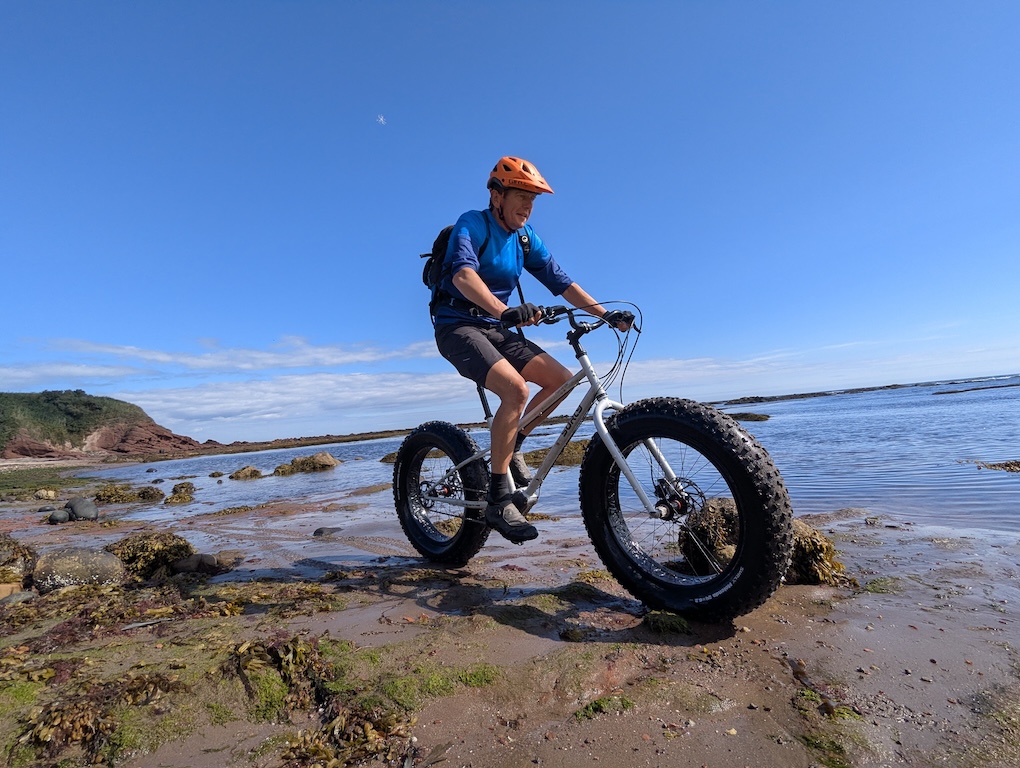




https://coastkid.blogspot.com/2025/01/surly-moonlander-20-day-ride-on-coast.html
I took the Moony over to the east coast of Scotland back in January to get the thoughts of the Godfather of Fat Biking in Scotland, Bruce Mathieson aka Coastkid.
Very cool video in there too.
Any questions from readers, happy to answer them.
Cheers
Sanny
Oh and apologies. Autocorrect changed their to there in the article. The shame. Someone call the grammar police!
The Grammar Police (me) failed you. Corrected it now! 🙂
Completely mental.
My first generation Moonlander is getting very rusty after too much alpine winter commuting. This could be the perfect replacement…
I took my fat bike out for the first time today in about 3 years, partly inspired by this article and that I’ve got a day trip to the Isle of Coll in about 10 days. If I lived in the Arctic, Cairngorms or somewhere with lots of sandy beaches I’d be tempted by a Moonie 2 – but I’ll stick with my Dillinger 5 shod, custom titanium for now.
To be fair @Ben Haworth, I see you more as a special PCSO than Grammar Policeman……..
@newretrotom
Go on, you no you want to………..
@dovebiker
Nice one. Always good to rekindle the fat bike love……..delighted that the article inspired you. That’s really lovely to hear.